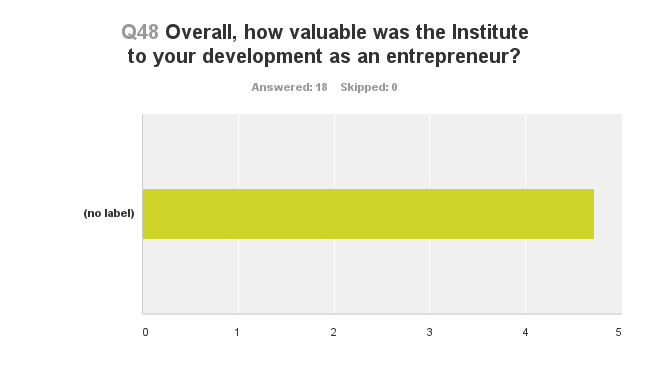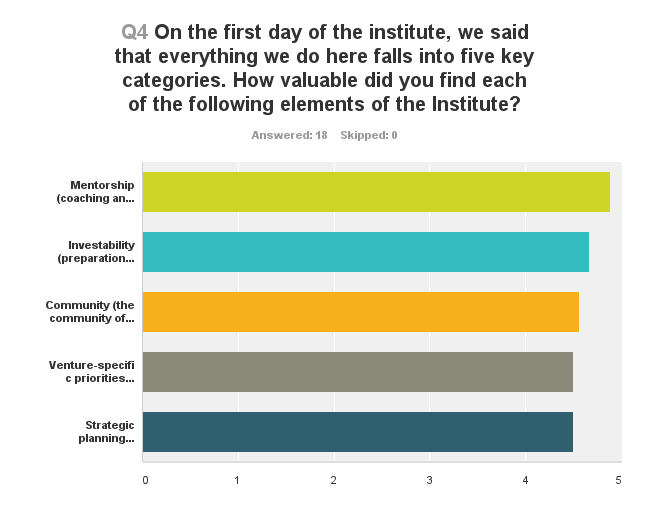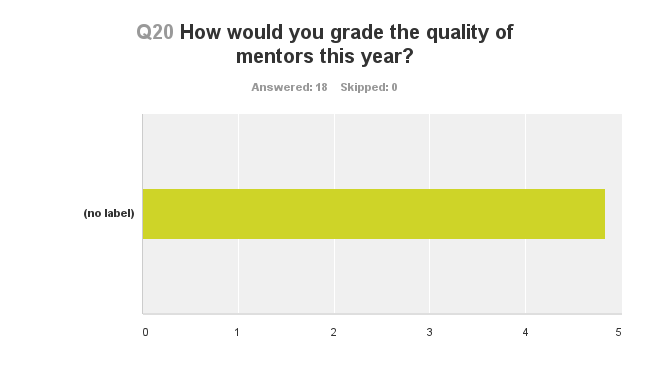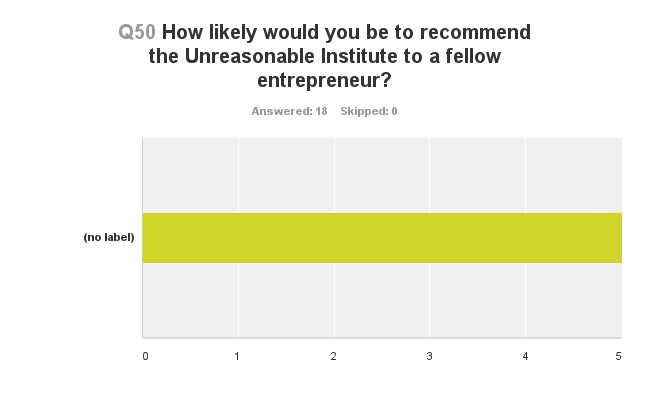The fifth Unreasonable Institute has come and gone. We have since synthesized what we learned and are already sharpening our offerings for the next few programs. (Coming up: Unreasonable Artisan in October.) This post details what we learned and how that highlights what we need to get right in the future.
First, a quick look at how we did this year, in graphs! These come from a 68-question survey that our entrepreneurs completed at the end of the Institute. (1 = poor or very unlikely; 5 = excellent or extremely likely.


While there are definitely some things we can improve upon, I am extremely proud of the Unreasonable team for pulling off such an incredible Institute this year!
The Key Lessons from 2014
1. The entrepreneur should be in the driver’s seat. We’ve been hearing for years that some of our entrepreneurs simply don’t follow up with mentors and funders they meet at the Institute. We found this bewildering. So after considering feedback from previous mentors and entrepreneurs, we made the following changes:
- Clearly defined roles (for us, the mentors, and the entrepreneurs). You can see the presentation that Banks Benitez, our chief entrepreneur officer, used to help clearly articulate the role of the entrepreneurs during the institute. And our single core message to the entrepreneurs: “You are in control. It’s your job to lead, follow up, frame, and ask the right questions. If you’re ever wondering whose job it is to make something happen with a mentor, we’ll make it easy for you: It’s always your job.”
- An entrepreneur workshop on engaging with mentors. This followed our 18 keys building relationships wth mentors and funders. We had the entrepreneurs practice how to start a conversation, explain their venture, draw it on a piece of paper, and explain the next steps. We even showed them how to write effective emails. (Our method for following up actually got featured in Inc. magazine.)
- Regular check-ins with entrepreneurs to ask them about how they were approaching mentors and to offer them guidance.
- Thank-you note card stations to encourage entrepreneurs to follow up.
These efforts, simple as they may be, seem to have worked. Mentors told us they had never seen a batch of our entrepreneurs so good at following up. And the entrepreneurs appreciated the extra effort we put into framing and told us they wanted even more.
2. Curation trumps serendipity: Why we’ll change some of our community events and end others. We carefully curate our mentor and funder networks and match relevant people to the entrepreneurs during the Institute. But to protect against the fact that we can’t possibly know everyone who might be valuable to an entrepreneur, we host two events that we are open to anyone who wants to buy a ticket: the Unreasonable Launchpad (formerly the Climax) and the Unreasonable Scrimmage. The Launchpad was open to the public and welcomed nearly 800 attendants who came to hear the entrepreneurs’ six-minute talks. The Scrimmage was a chance for the entrepreneurs to work with skilled professionals in the Boulder Community on specific problems in their venture.
This year’s entrepreneurs told us that these were our least helpful events. Some felt that they did more for Unreasonable Institute than for themselves. They posited the reason for this was that “the right people weren’t in the room,” leading to little benefit, especially considering the work they put in.
On the other hand, we put a lot of energy into curating mentors, funders, and other partners for our entrepreneurs, which were hailed as very high-value relationships for our entrepreneurs. Take a look at this chart, taken from a survey of the 18 entrepreneurs at the end of the Institute. (1 is poor, 5 is excellent.)

Moving into 2015, if we do events like the Launchpad and the Scrimmage, we will likely aim for smaller, more tightly curated events. In some ways, this is sad for us, because the community in Boulder so loves the Unreasonable Launchpad. However, we are here to serve the entrepreneurs, and this event just doesn’t produce enough value for them.
3. Bringing 30 mentors to the Institute in one weekend works! For the second year, we hosted “Mentor Weekend.” This took place two weeks into the Institute, right after the Launchpad, and brought the bulk of our mentors to the Institute. They participated in speed dating as well as deeper one-on-one sessions with our entrepreneurs and forged a lot of strong relationships. This was much better organized and attended than last year’s event, making us confident in this structure moving forward. Its effectiveness may also give us the a



